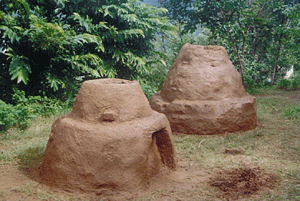|
Need/Problem
The scarcity of fuel for domestic or commercial
use in rural areas has become a chronic and severe
problem today. People, especially women, have to
spend several hours collecting firewood from distant
and, often dangerous locations. This is also causing
severe depletion of forests and tree resources.
To a large segment of the rural poor, fossil fuels
like coal and kerosene are out of reach, apart from
the fact that their reserves are fast dwindling.
On the other hand, it has been estimated that in
India, at least 150 million tonnes of forestry waste
and 350 million tonnes of agricultural residue are
available every year. A major portion of these is
either not utilised or is used very inefficiently.
Approach/Strategy
A
few technologies are available for their efficient
utilisation as fuel, prominent among these being
fluidised-bed combustion, briquetting of fuel after
pyrolysis and addition of binders and briquetting
of forestry/agricultural waste without binders taking
advantage of the lignin present. Conversion of biomass
into charcoal briquettes would not only benefit
users but would also generate employment in rural
areas. It can also be utilised to contain invasive
weeds like lantana, which have a high calorific
value.
Numerous charcoal production systems and imp-roved
techniques have been available or proposed for applications
ranging from a very small subsistence level operation
with mud beehive, drum and mould methods to very
large capital intensive operations with brick beehive
and retort methods. Introduction of appropriate
systems must take into account a number of socio-economic
and ecological factor
s.

Pyrolyser
|